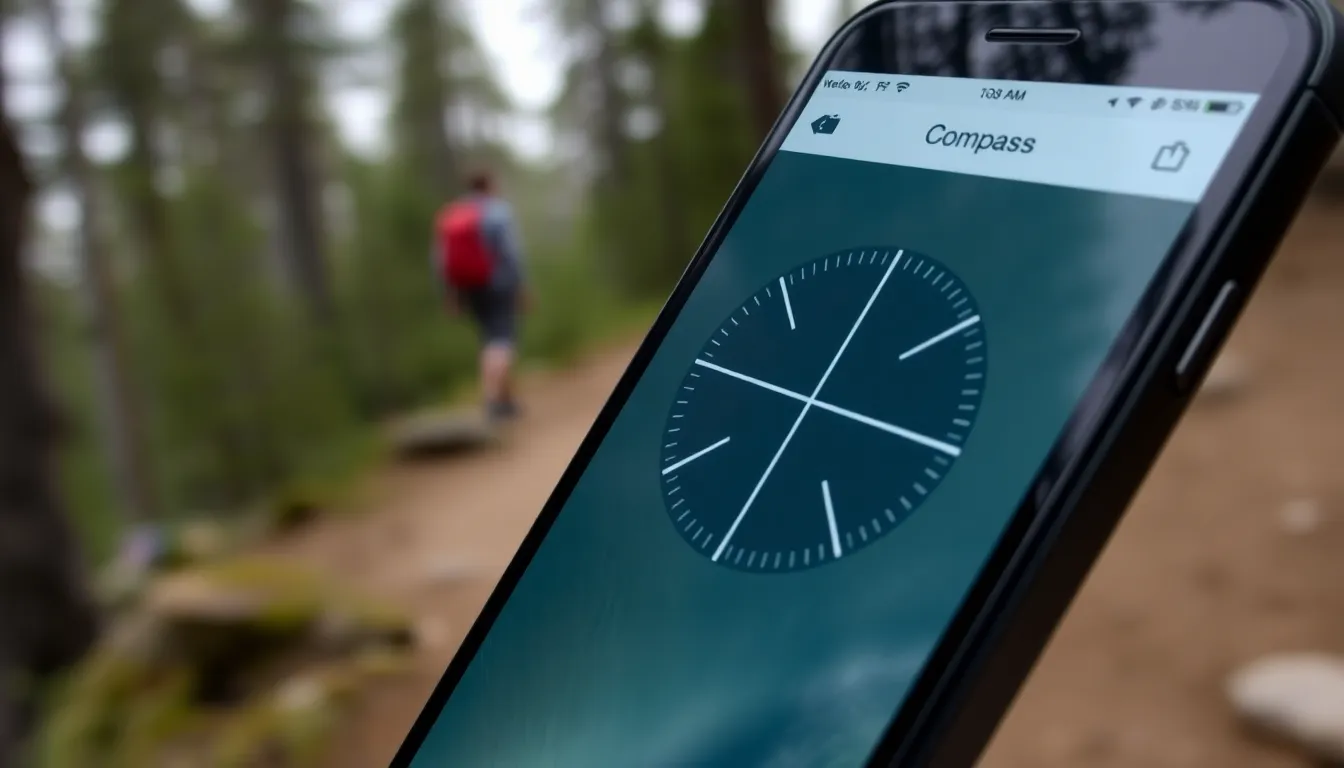Lost in the wilderness of your own iPhone? Fear not! The compass feature is here to save the day and guide you back to civilization—or at least to your favorite coffee shop. While it might seem like a hidden treasure in a sea of apps, finding the compass on your iPhone is easier than you think.
Table of Contents
ToggleUnderstanding The Compass App
The Compass app on the iPhone serves as a reliable navigation tool that utilizes built-in sensors. Users can find the app by accessing the home screen or by using the search function. Recognizing its location is important, as the app may not be as visible as other more popular apps.
iPhones equipped with iOS 14 or later include the Compass app. It features a simple interface showing direction, current location coordinates, and elevation. The app operates seamlessly, delivering accurate readings with minimal user input. Often, users might rely on the app for outdoor activities such as hiking or boating.
Location services must be enabled for the Compass app to function effectively. In addition to providing direction, the app also allows for calibration for enhanced accuracy. Some iPhones also offer a variation in the compass view, utilizing augmented reality features.
Individuals can quickly access features like “Waypoints,” allowing for quick navigation to saved locations. The app functions independently of cellular service, so it remains useful in remote areas. Frequent updates ensure the Compass app runs smoothly, providing reliable navigation tools regardless of conditions.
The Compass app integrates seamlessly into the iPhone’s functionality, supporting navigation while enhancing outdoor experiences.
Locating The Compass On iPhone

Finding the Compass app on an iPhone is easy. Users can quickly access it through a few simple methods.
Step-by-Step Guide
- Swipe down from the middle of the Home screen to open Search.
- Type “Compass” in the search bar.
- Tap the Compass app icon when it appears in the results.
- Alternatively, locate it within the Utilities folder on your Home screen.
- In case it’s missing, check the App Library to find it.
Accessing Through The Control Center
Accessing Compass through the Control Center provides quick navigation. Begin by swiping down from the top right corner of the screen. Find the icon resembling a compass among other controls. If the icon isn’t visible, users can customize the Control Center settings. Go to Settings, then Control Center, and add the Compass feature. This customization allows for instant access to Compass whenever needed.
Features Of The Compass App
The Compass app on the iPhone offers several key features that enhance navigation and outdoor experiences.
Calibration
Calibration ensures the Compass provides accurate readings. Users can manually calibrate the app by rotating the device in a figure-eight motion. The app will prompt when calibration is necessary, enhancing reliability during use. Regular calibration maintains accuracy, particularly in areas with magnetic interference. This feature supports precision, which is vital for activities like hiking or geocaching.
Additional Functions
Additional functions of the Compass app expand its usefulness beyond basic navigation. Users can access “Waypoints” to mark significant locations for easier navigation later. The app also records elevation data, which is beneficial for outdoor enthusiasts tracking altitude while hiking. In the settings, users can customize the compass display, choosing between degrees and cardinal directions. Besides, the app functions without cellular service, making it invaluable in remote areas. These features collectively enhance the overall user experience while navigating different environments.
Troubleshooting Compass Issues
Compass issues can arise for various reasons on an iPhone. Users might notice inaccurate directions or a non-responsive app. To address this, first check if location services are enabled. Navigating to Settings, then tapping Privacy, and selecting Location Services can help determine if the Compass app is allowed access to location data.
Calibrating the compass can also resolve issues. Users should rotate their device in a figure-eight motion, which assists in obtaining accurate readings. When calibration is successful, the compass compass will show a prompt indicating it’s calibrated.
Another common issue involves magnetic interference. Areas with high magnetic fields, such as near electronics or metal objects, may disrupt compass functionality. Stepping away from these sources often restores accuracy.
Restarting the device is a reliable troubleshooting method. By turning off the iPhone and then switching it back on, it can refresh the software, potentially resolving the compass problems.
Updating the iOS may also improve app performance. Navigating to Settings and selecting General, followed by Software Update will indicate if an update is available. Keeping the software current ensures that users benefit from the latest features and fixes.
If problems persist despite these steps, deleting the Compass app and reinstalling it from the App Store can reset any underlying issues. This action often resolves glitches or corrupted files that might affect performance.
Lastly, contacting Apple Support may provide additional assistance for persistent issues. They offer expert advice and solutions tailored to unique problems.
The Compass app on iPhone is an invaluable tool for anyone seeking reliable navigation. Its ease of access and user-friendly interface make it perfect for outdoor enthusiasts. With features like Waypoints and elevation tracking, it enhances any adventure. Regular calibration ensures accuracy while troubleshooting tips help maintain optimal performance.
Whether users are hiking in the mountains or exploring a new city, the Compass app provides essential guidance. By enabling location services and customizing settings, they can make the most of this powerful feature. Embracing the Compass app can transform how users navigate their world.






